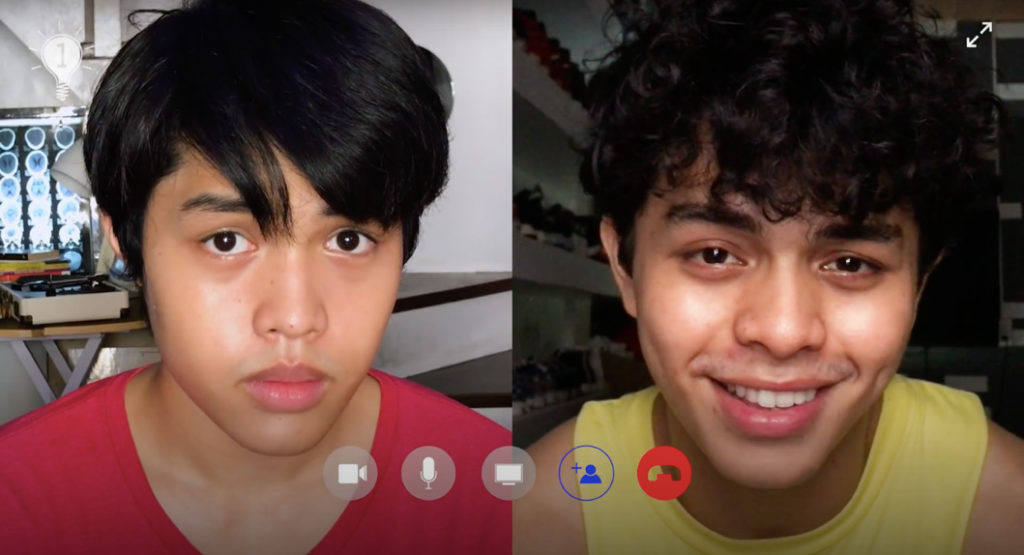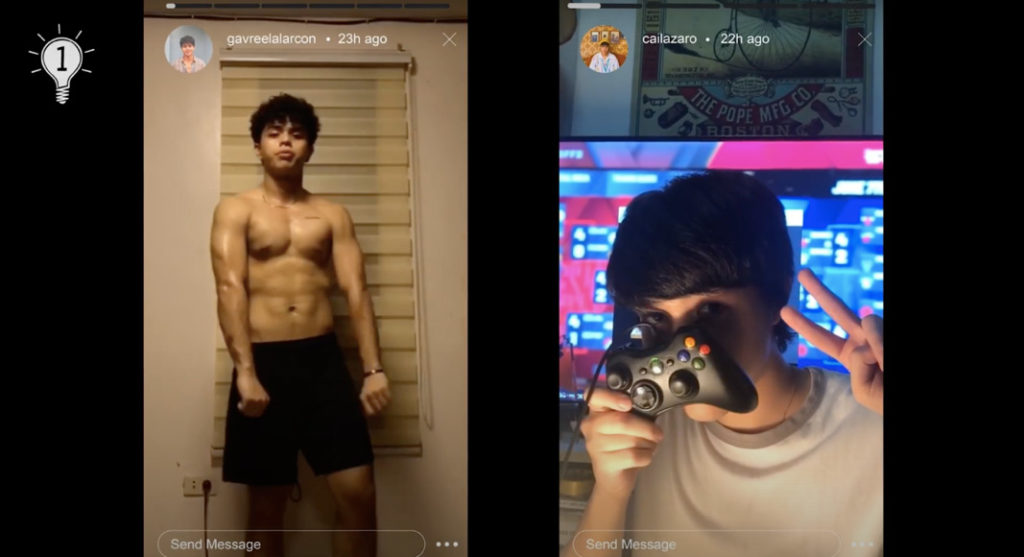【by Christian Jil R. Benitez, Dec. 2021】

Still from Gameboys (2020) pilot episode.
That the first self-identifying “boys love” (BL) series from the Philippines—Gameboys (The IdeaFirst Company, 2020)—emerged during the first few months of the global pandemic is crucial to the prospect of queerness it embodies. The series follows a recognizable BL arc: one day, Cairo (Elijah Canlas), a game streamer, serendipitously encounters Gavreel (Kokoy de Santos), who forthrightly initiates a romantic pursuit; despite Cai’s early attempts to rebuff Gav’s efforts, as well as other detours along the way (among them, the resurfacing of Gav’s ex-boyfriend, Terrence (Kyle Velino), who wishes to win him back; and the unfolding of Cai’s difficulties with his family, stemming from his current grappling with his own sexuality), the two boys—as protagonist boys are all bound to in the BL universe—eventually falls for each other. At the same time, the series also exhibits tendencies shared with the Filipino teleserye (“television series”), such as having its “narrative placed in the context of the family”[1] and, following its critical acclaim all over the world, promptly creating its transmedial extensions, including the additional three episodes to the originally planned ten; a direct film sequel; a script book; an off-shoot series (that centers on girls love (GL), no less); and a still impending second season.[2] However, above all these, what particularly strikes in the series is its use of multiple frames, which discursively makes apparent an alternative, if not urgent form of intimacy.
For the most part, Gameboys takes place online, through the video stories posted by the characters as they go about their daily lives; clips that give an overview of their respective social media accounts and chat messages; and, of course, video calls among themselves. This recourse to the digital world ingeniously allows the series to both contemporaneously represent what has become of our relationships in the time of social distancing, and provide a practical means for the production to commence itself while abiding to the necessary health protocols at the time.[3] And so, whenever the characters engage in real-time verbal communication, they would simply appear on-screen in close-up, looking directly to the camera and to the other who is framed—from the viewers’ vantage—adjacent to them. In effect, as the characters speak to each other, they also seem to speak directly to the viewers—an impression that is more crucial considering how Gameboys was originally released via YouTube, and hence primarily accessed via devices through which one can similarly go online and rehearse the same digital practices that the characters enjoy, rendering then the experience of watching as if the viewers themselves also partake in the very diegetic encounter. To put it another way, one can imagine that from the characters’ end, the viewers can also be found within similar frames on their screen, present in the same video conference room, although ultimately invisible, hidden from these characters’ eyes.
It is, in other words, as if the audience becomes the couple’s “third wheels”[4]—however not simply in the way that they are onlookers beholding the audiovisual material, and thus under the presumption of a rigidly clear “cut”[5] between the subjects (the spectators) and the object (the spectacle); but instead as participating presences, too,“within” its BL universe, in their corporealities that somehow traverse these “worlds.” Something posthuman, therefore, is proposed to be at work, intimating intersections and implications—indeed, refractive involvements—with the BL universe of the so-called “real world,” or that field often construed as the former’s other, if not outright contrast.[6] For after all, as much as the life of Gameboys as a material primarily depends on its fan base,[7] the converse also appears to hold true: the series—and perhaps, the BL phenomenon writ large—has been crucial for the survival of many in the Philippines,[8] yet not in the mere escapist sense of bourgeoise pleasure-taking from the material, but in terms as well of the expansive imagination it dares us to practice in a time as constricting as the present, particularly toward the possibility of happiness for queer Filipino subjects.[9]

Still from Gameboys (2020) pilot episode.
And yet, queerness in BL must be also intuited beyond the diegetic entanglement of boys among themselves, and perhaps as a mode, too, of becoming with the vicissitudes of everyday—even, and especially so, for the audience themselves. It must be realized, for instance, in the possibility of our anthropomorphic selves letting emerge a certain strange intimacy with things distant (tele) and deferred (serye)—things that we presume to simply “watch” from afar—and to be “interrupted by [their] indeterminable capacity” to do so,[10] time and again, if only to remind us in the end that we are as much framed as we frame things around us. In other words, it is such queerness that takes into account “the intercorporeality and intersubjectivities and inter(dis)embodiments of dwelling in cyberspace and in the integrated circuits of technology.”[11] Simply put, we are queer and we queer by the sheer virtue of our cyborged lives, in the middle of the global pandemic, in our attempts to adapt to, and make livable and intimate still, the perverse quarantine.
Here, it is instructive to turn to another example from Philippine popular culture that similarly demonstrated the critical opportunities presented by Gameboys: the AlDub phenomenon, or the pairing between Alden Richards and Maine Mendoza, hosts of the noontime T.V. show Eat Bulaga, whose activating moment was an instance of kilig caught live on national television. During one of the program’s segment, in which the screen is halved to show those in the studio and those deployed outside in residential areas, as Maine—playing her character “Yaya Dub,” after the then trending platform Dubsmash—delivered her signature lipsync performance on a street of Manila, the other screen suddenly featured Alden’s face, whose smile jolted the former out of her character. The other hosts, quick to realize the chemistry between the two, easily teased them into a ship, giving birth to the program’s another segment: Kalyeserye (“road series”), a daily improvised comedic teleserye starring Maine and Alden, which narrates their blossoming romance despite the distance and eventually culminates to their meeting at long last in the flesh, within a single frame. Considered a global phenomenon with the record-breaking social media engagements it has instigated,[12] the pairing was then subjected to “overexposure—six days on TV, countless endorsements, huge billboards, magazine covers, record deals, trips abroad, etc.”[13]

Still from “KalyeSerye Day 1: Ang Simula ng Forever.”
Although a lot has already been said in attempts to explicate this “unexpected and unpredictable” media phenomenon,[14] most of which relies on its supposed intimation of the Filipino popular consciousness, what a particularly posthumanist perspective adds to the conversation is a crucial attention to the technological form that has enabled everything to take place: the real-time split-screen, which renders the act of watching not only performed by the viewers at home, but also by the personalities themselves, given the improvisatory work necessitated by the event itself. This, coupled with the fact that the warm reception of millions of viewers has encouraged the further transmedial ventures of the love team, ultimately queers the notion of spectacle itself, in the sense that it can now be seen as a collaboration, if not a corroboration, between various material agencies, both “human” (as stars and as audiences) and “nonhuman” (the technologies and environments involved, for example), whose categorizing cuts among themselves are now perceived to be somehow blurred. For one, human touch on screen—the shape of a heart formed by two hands, or even a kiss—becomes possible only because prostheticized by the screen itself. The irony of the line supposedly separating, therefore, is its potency toward such assemblage.

Still from Gameboys (2020) episode 4.
While Gameboys is less experimental than the AlDub phenomenon on at least two accounts—namely, that it is not performed live, and that its most vital form of multiple frames has been already derived after the said media event—the assimilation of the series to the specific Philippine present, with the current propensity of the latter for online social entertainment, the BL genre, and digital communities, has rendered Gameboys as a moment crucial to both the contemporary entertainment history in the country, and efforts to articulate posthumanism from such context, if not from Asia in general. For one, it offers the nascent field of fan studies in the Philippines, often regressively contemplated through the meagre framing of consumption, an opportunity for rethinking, taking into consideration how the digital circuitry alters what being a fan could possibly mean and entail—from being a discourse on distance with relation to the idol, for instance, and toward an embrace on such distance as integral, in fact, to the experience of adoration and pleasure themselves. The latter, in turn, would then allow us to reconsider, too, our ideation of intimacy, which in troubling our sense of what is “inmost” also reconfigures, and even disfigures, our understanding of both space and time: that perhaps, in such context as now, what is distant and deferred would also be recognized as something so close it is already entangled with us—a vision that might be instructive for our survival in the present, if not the subsequent times.
And so, when Gameboys and other similar BL series are being hailed as intimating of “struggles [that] are our [the Filipino audience’s] struggles,”[15] what can be intuited now is how such appraisal also supersedes discourse of representation, that is, how BL purportedly provides a portrayal of complexities encountered by queer Filipino subjects; and instead, suggests how these audiovisual “objects” are indeed sites of contestation in which the audience, previously thought of simply as phenomenological “subjects,” are also material agents most involved with the former’s constructions and elaborations. Something is thus at stake—on the line—on these frames we watch so devotedly online: perhaps our own queerest quarantined lives.
AUTHOR
Christian Jil R. Benitez, Ateneo de Manila University, Philippines
NOTES
[1] In his now deleted Twitter account, teleserye scholar Louie Jon Sanchez (@ljsanchezph) wrote: “We fell in love more to the young lovers for they are good children to their parents, brothers to their siblings. The BL becomes teleserye for the narrative is placed in the context of the family” (“Lalo pang napaibig sa atin ang mga kabataang mangingibig sapagkat mabubuting anak sa mga magulang, mga kapatid sa kanilang kapatid. Nagsateleserye ang BL dahil itinanim ang kuwento sa konteksto ng pamilya”); see in John B. Bengan, “Isang Haraya ng Lambing: Ang Pagsikat ng Boys’ Love sa Pilipinas sa Panahon ng Pandemyang COVID-19” [“An Imagination of Tenderness: The Rise of Boys’ Love in the Philippines During the COVID-19 Pandemic”], Katipunan 6 (2020): 30n6, 39, accessed September 20, 2021, https://ajol.ateneo.edu/katipunan/articles/233/6734.
[2] These transmedial extensions, as additional capitalistic ventures, also demonstrate what Sanchez surmises as the contemporaneity of the teleserye; and yet, at the same time, these extensions also go beyond the reflectiveness (“[pagka]sumasalamin”) of such contemporaneity, given that there is an actual material interaction between the teleserye itself and the audiences themselves via such further transmedial productions. See Sanchez, “Teleserye at Kontemporanidad” [“Teleserye and Contemporaneity”], Katipunan 5 (2020): 86, accessed September 20, 2021, https://ajol.ateneo.edu/katipunan/articles/232/6819.
[3] For the latter, see Perci Intalan, “Finding our North Star in Gameboys,” The Philippine Star, July 27, 2020, accessed September 20, 2021, https://star34.philstarlife.com/article/869605-finding-our-north-star-in-gameboys.
[4] “On Gameboys: The Baby, the Gago, and Carly Rae [Part 1],” Squeeze, August 19, 2020, accessed September 20, 2021, https://squeeze.ph/on-gameboys-the-baby-the-gago-and-carly-rae-part-1/.
[5] Karen Barad, Meeting the Universe Halfway: Quantum Physics and the Entanglement of Matter and Meaning (Durham & London: Duke University Press, 2007), 114.
[6] For instances of such contrasting, see Ryan Macasero, “Filipino BL: How ‘Gameboys’ gets it right,” Rappler, August 3, 2020, accessed September 20, 2021, https://www.rappler.com/entertainment/series/gameboys-filipino-bl-series; and E. Avena, “‘Gameboys’: How the Lockdown Unleashed a Modern Love Story,” Rank, July 4, 2020, accessed September 20, 2021,https://www.rankthemag.ph/review-gameboys-lockdown-unleashed-modern-love-story/. Elsewhere, I attempt to provide a counterpoint, asserting that there exists a continuity between the “BL universe” and the “real world,” one that is founded on the sense of irony; see “Constellating Romance,” Young Critics Circle Film Desk, November 11, 2021, accessed November 13, 2021, https://yccfilmdesk.wordpress.com/2021/11/11/constellating-romance/.
[7] See Intalan.
[8] For instances among the countless testaments of fans regarding the existential gravity of BL, see Don Kevin Hapal, “SarawaTine helped keep myself ‘2gether’ during the lockdown,” May 15, 2020, accessed September 20, 2021, https://r3.rappler.com/entertainment/tv/261013-sarawatine-helped-keep-myself-2gether-coronavirus-lockdown; and Rye Quizon, in Toni Potenciano, “Which lockdown hobby took over your life?,” CNN Philippines, March 17, 2021, accessed September 20, 2021, https://cnnphilippines.com/life/culture/2021/3/17/one-year-lockdown-hobby.html. For Gameboys in particular, see Macasero; and @surethingpating @rappercairo and @kolokoyforever, “A Community Reacts: How ‘Gameboys’ Gave the Pandemic, our Culture, and the World a Major, Necessary Rewrite,” Rank, September 20, 2020, accessed September 20, 2021, https://www.rankthemag.ph/perspectives-gameboys-finale-rewrite-community/.
[9] Bengan nominates such imagination to be that of tenderness (lambing): “the pursuit or comforting of a person displeased or sulking, tendencies always shown in Thail BL, that ultimately arrives to “tenderness” (“lambingan”)—the sweet intimacy of two people” [“ang pagsuyo o pag-alo sa isang taong nagtatampo o nagmamaktol, mga ugaling palaging ipinapakita sa Thai BL, na hahantong din sa ‘lambingan’—ang matamis na pagdadaiti ng dalawang tao”] (9).
[10] Benitez, “Telepathic Visions: On Alvin Yapan’s An Kubo sa Kawayanan (2015),” Res Rhetorica 8, no. 2 (2021): 57, accessed 20 September 2021, https://doi.org/10.29107/rr2021.2.4.
[11] Edmond Y. Chang, “Technoqueer: Re/Con/Figuring Posthuman Narratives” (PhD dissertation, University of Washington, 2012), 4.
[12] See Heather Chen, “‘‘AlDub’: A social media phenomenon about love and lip-synching,” BBC, October 28, 2015, accessed September 20, 2021, https://www.bbc.com/news/world-asia-34645078.
[13] Richard Bolisay, “The Good and the Bad: AlDub in Film,” Plaridel 13, no. 2 (2016): 247, accessed September 20, 2021, http://www.plarideljournal.org/article/good-bad-aldub-film/.
[14] Patrick Campos, “On the AlDub Kalye Serye Phenomenon – A Roundtable Discussion,” Plaridel 12, no. 2 (2016): 217, accessed September 20, 2021, http://www.plarideljournal.org/article/roundtable-discussion-aldub-kalye-serye-phenomenon/.
[15] Macasero.